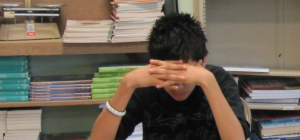 Her name was Mary Thorson. Her pictures show curly brown hair, light brown eyes, a wide smile, and a button nose. Her bronzed complexion hints of African-American ancestry. Mary stepped out in front of a semi-truck. This 32-year-old teacher who taught in Ford Heights, Illinois, left behind a six-page suicide note, mostly about her job. While looking up her half-remembered story, I stumbled upon a Chicago English teacher, Joseph Hillebrand, who had stepped in front of a Metra train.
Her name was Mary Thorson. Her pictures show curly brown hair, light brown eyes, a wide smile, and a button nose. Her bronzed complexion hints of African-American ancestry. Mary stepped out in front of a semi-truck. This 32-year-old teacher who taught in Ford Heights, Illinois, left behind a six-page suicide note, mostly about her job. While looking up her half-remembered story, I stumbled upon a Chicago English teacher, Joseph Hillebrand, who had stepped in front of a Metra train.
Mary had served honorably for eight years in the Army Reserves, but her position in a small, impoverished school district proved so stressful that she chose suicide by semi on a major Illinois expressway. Reading between the lines, her stress seemed mostly to be coming from problems with administration, and other teachers reported administrative bullying. Mary had already been suspended once from her position after allegedly striking a student, a gesture she called a “playful tap”, and she would be suspended again the week before her death for cursing at a student, according to a coworker.
Yet Mary was a caring teacher. In a district where more than 98% of students were classified as low income, Mary used her own money to buy school supplies and even warm clothing for students. A fellow physical education teacher said her students loved her and “gravitated” toward her.*
Toxic work environments in education have become big news in the recent past. I remember the Brooklyn teacher who faked a fall down her school’s stairs to avoid a poor performance review. I have held crying colleagues devastated by those reviews, especially after Illinois, like other states, decided to rely on the Charlotte Danielson rubric to judge teachers. Suddenly, many points were in play, and performance was boiled down to numbers, many of them made up, since no one can assess twenty-two areas of expertise by watching one person for an hour or less.
Mary Thorson was expected to go home for the holidays on the night of Thanksgiving, Nov. 24, 2011. She never made it. Instead, the police showed up with the saddest news any parent can receive. I am sure there have been no happy Thanksgivings since that tragic day.
Eduhonesty: What if Mary had been carrying a gun? She would have been an extremely plausible teacher to arm with her eight years of honorable military service. That semi-truck became a weapon of opportunity. What might she have done with a gun instead?
I fell in my school parking lot years ago. I still remember a coworker’s loud, plaintive shriek, as she came over to help me up: “Why couldn’t it have been me?!!??” If she had fallen, I am sure her teaching years would have ended in that parking lot that day. She was nearing the edge, the throw-yourself-down-the-stairs edge. I just got up and dusted myself off, a lucky fall onto the ice in my long, thick, down coat.
Here’s my take on the arm-the-teachers plan. If we do, I believe one of those teachers tempted to throw herself down the stairs will shoot her Principal instead. Or she will shoot the students in her afternoon English class, the ones who made fun of her when she tried to introduce the new project that she had cut sleep to prepare the night before.
According to Fast Facts from nces.ed.gov., in 2015 the U.S. had over 3 million public school teachers. Pick any group of 3 million people and you will find a number who are overdue for mental healthcare, a number who are taking the wrong meds, too many meds or none of the meds they have been prescribed. Even men and women who have always shown solid mental health unravel sometimes, unable to manage after a family death or an unexpected affair and divorce. Add to that the fact that teaching can be an extremely high-stress job, especially in poor and urban districts trying to hit unrealistic test-score targets. Let’s throw in the factoid that around one-half of public school teachers quit within the first five years, unable or unwilling to do a job for which they may still owe many thousands of dollars of student loans. That figure gets bandied about regularly, although I am not sure it’s up-to-date. The number may be higher today.
If even a fraction of fraction of 1% of those more than 3 million teachers lose their temper while armed… The body count will rise swiftly. And all those nifty new locks we keep installing in schools across the nation? Those locks will be useless.
Some of the sanest people I know have ended up seeking out mental health care in times of crisis. Others simply crumbled. They crawled into bed and came out months later, when they came out at all. Being a teacher in no way guarantees mental health. Nothing guarantees mental health.
If we arm our teachers, we will be meeting a new enemy — and that enemy will be us.
P.S. This post ignores one other aspect of arming teachers that requires at least a mention. That football player who once pushed me out of a doorway because he was bigger, stronger and determined not to let me slow him down? What if he had decided to go for my (then-nonexistent) gun instead? As we add guns, we add to the risk that students will gain access to these guns, accidentally or deliberately.
*http://www.substancenews.net/articles.php?page=2961




